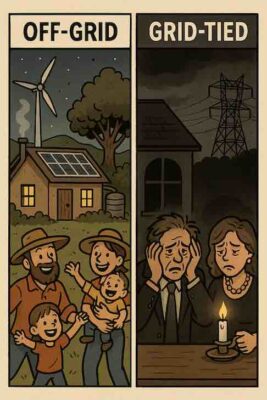
Living in the US? You had better get yourself a community micropower station before electricity prices skyrocket and the grid goes down. Go to off-grid.net/locaenergy
Big Tech is gobbling electricity like there’s no tomorrow. Giant sheds full of computers, crypto rigs humming day and night, factories coming home from overseas — all plugging into an aging grid that wheezes every time the weather turns nasty. Bills are climbing, tempers are flaring, and the political class is too busy trading slogans to keep your fridge cold.
The crunch no one can ignore
Think of the grid like a creaky motorway at rush hour. More cars keep piling on, but no one’s added new lanes. On sweltering evenings the traffic just stops — and so does your air con. Utilities roll out diesel generators on trucks to stop blackouts. That’s not a plan. That’s a panic.
Old kit, long queues, higher bills
The boxes and cables that move power around America are old. Replacing them takes years. The special metal they need? Stuck in supply bottlenecks. Meanwhile, you’re paying more each month for the privilege of hoping the lights stay on. Millions already can’t keep up and are getting cut off. It’s starting to look a lot like Britain’s energy misery — only bigger.
Politics won’t keep the lights on
One side shouts “drill!” The other shouts back. Tariffs hit the very stuff needed to fix the grid. Wind and solar projects get tangled in red tape. New mega power stations take forever and arrive over budget. While everyone argues, demand keeps soaring. Your bill doesn’t care who won the last press conference.
The fast, local fix: a community micropowerstation
Forget waiting for a miracle in Washington. Neighbourhoods are building their own small power hubs — a few rows of panels, a chunky battery in a safe cabinet, and a backup generator for long outages. On a normal day, it cuts your bill. On a bad day, it keeps the lights, the internet, the fridge and the medical kit running.
Plain English version:
-
Solar makes cheap power when the sun’s out.
-
A battery saves the extra for the evening peak, when prices bite.
-
Smart plugs and simple timers shove the “not urgent” stuff (car charging, laundry) to cheaper hours.
-
If a storm knocks the grid, the system “islands” — your street looks after itself until the lines are fixed.
Who should do this first?
New suburbs near those massive data centres. Rural towns at the end of long lines that fail in storms. Apartment blocks with a history of outages. Clusters of essentials — clinic, supermarket, phone mast, water pumps. In other words: places that can’t afford to go dark.
How it pays for itself
Keep it simple and local. A neighbourhood co-op sells shares to residents. A school, store or warehouse signs up for a steady slice. The utility pays you to help reduce strain at crunch time (yes, that’s a thing). You save on bills, and the street earns by being useful to the wider grid — without relying on some distant promise.
What to watch out for (no jargon, just common sense)
Ask any installer to show three things on one page:
-
Blackout plan: What stays on if the grid fails — lights, fridge, medical kit, Wi-Fi? For how many hours in heat or cold?
-
Bill drop: Last summer’s electric bill vs. next summer’s with the system in. If they can’t show it, walk away.
-
Parts in hand: Are the panels, batteries and switches actually ordered? Long waits kill projects.
- add yourself to the off-grid micropower waiting list: go to off-grid.net/localenergy
How to start this season
Knock on doors. Form a small energy co-op. Get your building’s 30-day usage data (your utility has it). Shortlist rooftops and car parks with good sun. Get quotes from teams who’ve built working microgrids — not just shiny solar farms. Keep backup fuel as a last resort, not a lifestyle.
America’s lights are flickering. Time to power your street.
America can still build big things — but that won’t help you through the next heatwave or ice storm. A community micropower station is boringly practical: it cuts bills, keeps the essentials running, and takes pressure off those tired cables down the road. Stop waiting for permission. Power your street